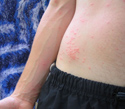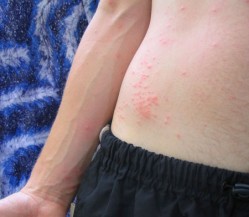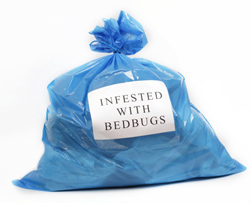
15 Sep “…Don’t Let the Bedbugs Bite.”
We’ve all seen the headlines detailing how bedbugs are storming back into our lives. From posh five-star New York hotels to the creepy motel down the street, no establishment seems immune to invasion.
Bedbugs, or Cimex lectularius, are about the size of a sesame seed or slightly larger and are clear to reddish brown. They lurk in the seams of mattresses, cracks in the walls, behind pictures, and in crevices of furniture. Some even dwell among those shoe boxes you keep under your bed, just like your childhood monster. Since they are wingless or possess just functionless wings, they must claw their way across the sheets to get to you. Like most blood sucking things, they are nocturnal. Bedbugs plague both humans and animals and their sole food is warm mammal blood.
Sometimes they leave behind fecal blood stains on the bedding since they defecate when loaded with your blood. That may be the only clue your place is infested since their bites are painless and don’t usually wake people. Their saliva reacts with humans’ immune systems differently from person to person. This is why everybody sleeping in the room could be on the menu but only about half of people will develop a rash to the bite site. So just because everyone is not showing signs of being bitten, doesn’t mean they are not fed upon also. Bedbugs like to feed weekly, but are known to go a full year without feeding if necessary.
A more mobile society and the popularity of secondhand furniture are given as reasons for the rising tide of bedbugs. The ban on DDT is also responsible for the comeback. DDT was so effective at controlling bedbugs that by the late 1950’s it was hard for researchers to even locate live bedbugs for laboratory purposes. Up until a few years ago, most people under 50 had never even seen a bedbug in their life.
It seems every foreign ethnic group has been blamed by the locals for spreading the disease. Those in Europe blame the fall of the Berlin Wall and the immigrants and displaced peoples from the Persian Gulf Wars. We like to blame Mexico. Whatever the cause, the future looks grim and they are here to stay from the looks of it. Bedbugs were once thought to transmit hepatitis but that has not proven to be the case. To date, no actual evidence of bed bugs as a disease vector is universally accepted.
Resistance to our pesticides is becoming a problem as well. It is very difficult to eradicate an infestation. If you put three pest control professionals in a room and ask which insecticide is best for bedbugs, they are very likely to disagree with each other. Some exterminators hedge their bets by spraying their own mixtures of several popular insecticides. Licensed exterminators can charge up to $1000 per room in large cities. Unlike a one-time DDT treatment, now repeat treatments may be necessary to kill any new bugs that were eggs when the first treatment occurred. A reported natural treatment is to place heaters in the room and raise the temperature to around 135 degrees. There are also commercially available CO2 traps one can buy to lure the bugs into little prisons. I’ve yet to see any evidence that these treatments are effective and don’t just prey on people’s fears. It is reported that trained dogs have almost a 99% ability to detect infestations but I don’t know of anyone around here offering this service yet. Spiders, cockroaches, and ants are bedbugs’ natural predators but not a very practical or hygienic approach to eradication. The masked-hunter bug is another natural predator but it can carry diseases itself. Other natural remedies are reportedly diatomaceous earth (powdered fossilized algae), crushed tobacco, black pepper, and black cohosh. A fun fact I discovered while doing research for this article is that DNA from human blood can be recovered from their abdomens up to 90 days after feeding. What a great piece of forensic science to work into a CSI episode!
There is nothing new about tolerating these critters. In fact the relative peace humans enjoyed from them after WWII up until now can be viewed as a historical anomaly. General MacArthur even referred to them as “a great nuisance” at US bases during the war. They’ve been mentioned also by Aristotle, Pliny and other authors throughout history back to 400BC ancient Greece. They remained rare in England until 1670. Imported wood to rebuild the city after the Great Fire of London in 1666 is blamed on that country’s subsequent bedbug surge. The fact that British settlements in Canada had reported them and local tribes were unfamiliar with the critters leads historians to believe it was yet another plague introduced from the Old World. Some old ship captains even implemented policies where passengers could not bring bedding onboard. They were once known as “red coats” and the “crimson rabble” in early America; probably a reference to the British.
There are some interesting cases winding through the courts involving tenants and landlords going back and forth over infestations and eradication methods. More than one person is claiming post-traumatic stress and “fear of beds” from having suffered a painless bite while asleep. In 2007 a lawyer and his wife from New York filed suit for several million dollars against the London hotel Mandarin Oriental. They claim they suffered hundreds of bites and subsequently brought the infestation back to their apartment building. Most lawsuits of this nature probably don’t get much attention as it is not the publicity hotels seek.
Patients bitten by bedbugs present to my office with simple inflamed bumps that often cannot be differentiated from mosquito bites. Sometimes, they are lined up three in a row and infamously known as “breakfast, lunch, and dinner sign”. Treatment is symptomatic since people’s bodies are not infested. I tell patients “I can control what’s on or in your skin, but not your environment.” There are several good licensed pest control services in the area I refer the patient to. If you have any question about identifying a bug that crosses your path, you can snap a photo of it on your phone and send it to IdentifyUS.com. For $20 you’ll get a Harvard trained entomologist to give you a response within an hour. When I travel, I use the luggage stand for my suitcase in hopes they will overlook it. I also do a cursory look behind the bed and between the mattresses. If I see anything remotely suspicious, I just ask for another room. It is unlikely that the entire establishment will be affected.
So as creepy as bedbugs make you feel, they are part of life now. Remember they don’t transmit any known diseases under normal circumstances. Mosquitoes and ticks are far more dangerous to our population, to put it in perspective. Our ancestors lived among them and so will we…until we figure how not to.
If you have a bedbug skin condition that can’t be controlled, contact Vita immediately for a treatment program. 530-528-VITA (8482)



